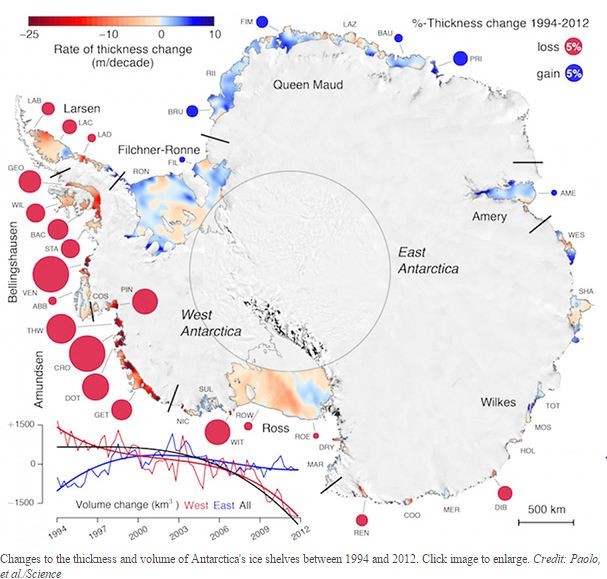The Antarctic ice shelves holding back an enormous weight of "grounded ice" from crashing into the sea and melting are themselves melting much faster than expected, said a new science study. And it's partly due to climate change.
The massive ice shelves, some larger than California, have been described as the linchpins of the Antarctic ice sheet system. They prevent millions of cubic miles of ice in the glaciers, in some places up to hundreds of meters thick, from plunging into the sea.
Scientists said Antarctica holds enough ice to raise global sea levels more than 200 feet if it all melted at once. They said this catastrophic event would be a planet killer will take hundreds to thousands of years, said Scientific American.
Despite this reassurance, scientists are worried the recent thinning of the ice shelves means there has already been an increase in the rate of Antarctica's contribution to sea level rise. What's worse, this melt is accelerating.
"We are starting to lose more ice at a faster rate; we're accelerating," said Helen Fricker, a climate scientist at University of California, San Diego's Scripps Institution of Oceanography.
More alarmingly, the rate of shrinking has increased by 70 percent over the past decade. That estimate is based on satellite measurements of the ice taken over an 18-year period.
Fricker and her graduate student, Fernando Paolo, compiled 18 years of satellite data from 1994 to 2012 recorded by three overlapping European Space Agency missions that measured the volume of Antarctica's ice shelves using radar altimetry.
What they found was the massive ice shelves were losing some 30 to 50 cubic miles of ice per year over that period. Also in that span, the rate of ice loss accelerated by an average of 7 cubic miles per year.
"So there's a loss, but that loss is increasing," said Paolo, the lead author of the study published in the March 27 issue of the journal, Science.
Fricker said the thinning ice shelves are "stopping that grounded ice flowing off the continent into the oceans, just by being there. So it's like a restraining force."
A portent of what a disaster like this could look like occurred in 2002 when the Antarctic's Larsen B ice shelf collapsed in just three weeks. Measuring 650 feet thick and 1,250 square miles, the now vanished ice shelf was the size of Rhode Island.
Fricker said the grounded ice in the west Antarctic alone might raise sea levels around the world by more than 9 feet. How much the ice shelves melt depends on how much climate change warms the Earth and on local conditions around Antarctica.
Polar climate scientist Richard Alley at Penn State University said the accelerated ice shelf shrinking was being caused by "some combination of slightly warmer water but more so it is winds changing in ways that bring warmer water to the ice sheet."
The warmer water melts the floating ice shelves from below, he said.



























